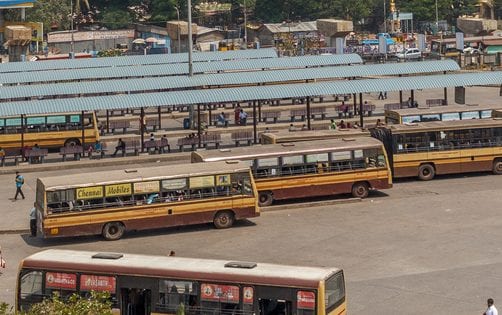
Amid challenges, public transport may change forever due to COVID-19
Even as policymakers and experts have come up with standard operating procedures for public transportation while combating COVID-19, it is not going to be an easy ride for passengers who grapple with social distancing and going contactless in a mode that is used to being crowded and infrequent.

Even as policymakers and experts have come up with standard operating procedures for public transportation while combating COVID-19, it is not going to be an easy ride for passengers who grapple with social distancing and going contactless in a mode that is used to being crowded and infrequent.
Earlier this month, Road transport and highways minister Nitin Gadkari said that public transport will be opened up with guidelines, and will adhere to norms like social distancing and safety measures like masks and sanitisers. Tamil Nadu Government also came up with a set of guidelines that included maintaining occupancy of below 50 per cent and the use of digital payment methods for tickets in the state transports.
In the COVID-19 world, when public transport will resume, the system will be fraught with challenges, says a source from the State Transport Department in Tamil Nadu.
Take the case of the buses operated by the Metropolitan Transport Corporation (MTC), every day there are about 35 lakh people plying in these buses—almost half the population of Chennai. With about 3980 buses operating in 800 plus routes, the buses are overcrowded, infrequent and unreliable.
The source said, “If we go with the guideline of occupancy at 50 per cent, we have to double the fleet. We will be giving protective gear to the staff, going cashless and contactless for the tickets and follow disinfection regimens after trips, etc. However, these cannot be sustained in the long run, as we know that the infection will last for a while.”
Not just Chennai’s MTC, Bangalore Metropolitan Transport Corporation (BMTC) and the Delhi Metro Rail Corporation have been working on guidelines that put social distancing and use of masks in the centre of plans.
BMTC has taken a decision to disallow standing commuters to ensure that the ride remains contactless for passengers, while it is looking at ways to issue tickets to people who do not have access to smartphones. BMTC is also mulling using a QR code ticket mechanism and weekly passes to ensure contactless ticketing services.
The source also pointed out that going cashless and making conductors just managers of the bus travel will also require hardware and software that comes at a considerable price.
Related news: Public transport may resume soon with guidelines, says Gadkari
“All this at a time when transport systems are not bringing in much revenue,” observed the source.
Why public transport
Public transport – be it buses, suburban trains or metro trains – will help sustain the difference we have seen in the environment, due to the lockdown, said Sivasubramaniam Jayaraman, manager- Transport Systems, Institute for Transport and Development Policy (ITDP), India programme, an organisation that has been batting for high-quality public transport.
He added that China which opened its public transport saw at least 80 per cent of its passengers coming back to use them.
“This may happen in India too. Transport undertakings must cater to the demand without compromising the safety of its commuters,” he said.
He also pointed out that the COVID-19 has provided Indian cities with an opportunity to transform their public transport services by improving user experience through technology, investing in public transport as a social good, reforming informal transit services and promoting walking and cycling for shorter trips.
However, even as experts say that this shouldn’t be an opportunity for the public to turn to private transport, cities like Bengaluru are using the break the commuters have taken from public transport to scale up its operations.
Shikha, managing director, Bengaluru Metropolitan Transport Corporation, said, “We have already proposed the procurement of 1500 diesel buses and electric buses, but everything comes with a cost and we are working on a financial model. We will gradually increase the fleet. When we begin operations again, we are expecting a reduction in passengers as most will continue relying on private vehicles like two-wheelers, as they did during the lockdown.”
Integrate public transport
Coming back to Chennai, where the modes are aplenty with a separate set of challenges like buses, suburban rail, metro train services and feeder services like share autos, an integrated system will be the way forward.
Related news: Centre readies stimulus 2.0, may open public transport after lockdown
Jayaraman said that bodies like the Chennai Unified Metropolitan Transport Authority (CUMTA), which was notified in 2019, a single nodal agency for all transport-related issues, will serve the purpose of making transport faster, safer, and convenient.
“When empowered, CUMTA ensures that dialogues related to various modes of transport happen on a single platform. Developed countries have shown that integration and coordination will pave way for effective and high-quality transport services,” he added.
ITDP recommendations for buses
- Only commuters wearing masks must be allowed to board the bus.
● Conductors must ensure passengers queue-up to board, alight the vehicle and ensure it doesn’t get overcrowded.
● Contactless ticketing options like passes and digital payments must be developed and promoted.
● Agencies must communicate relevant and updated passenger information to avoid overcrowding and confusion.
●Terminals, bus stops, and buses must be sanitised regularly.

